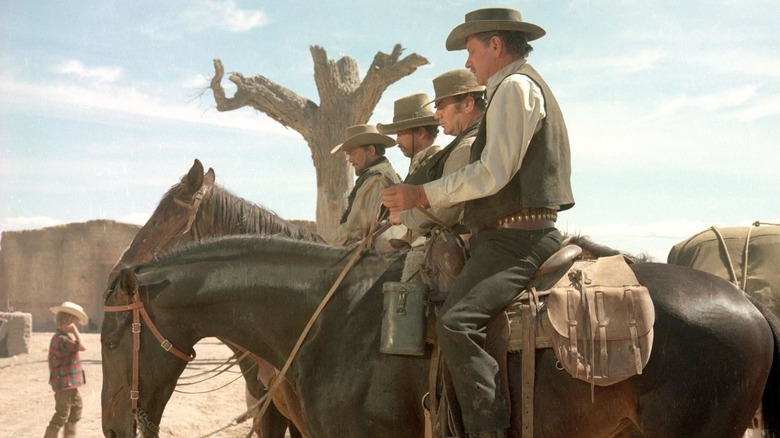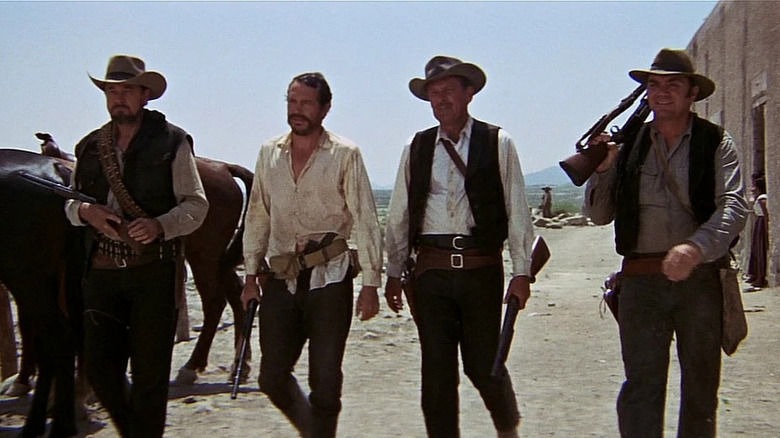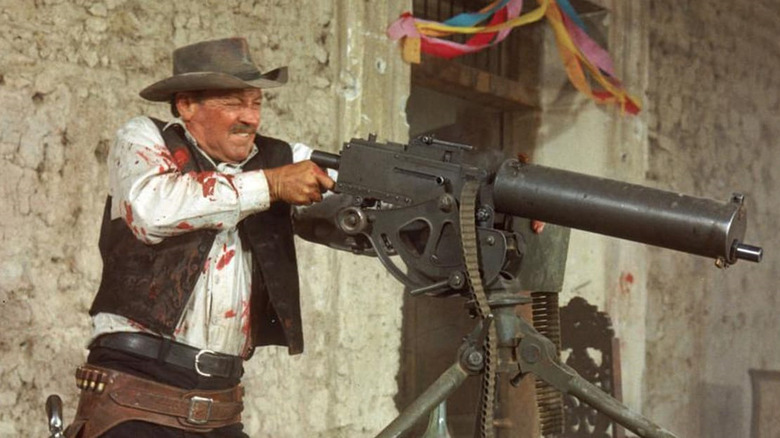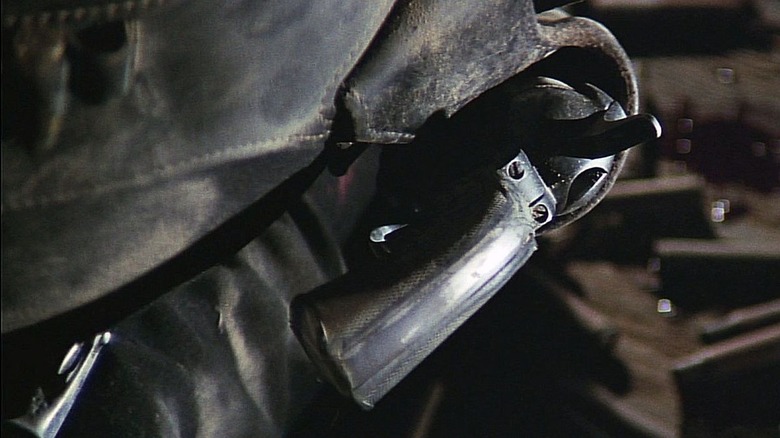Shooting The Wild Bunch's The Battle Of Bloody Porch Scene Was Exhausting
From the striking open credits, where we see a group of giggling children torturing a pair of scorpions with a swarm of angry ants, it's clear that "The Wild Bunch" is a movie on a mission. There is no innocence left in this bug-eat-bug world, it says right off the bat, and the gleeful nastiness of the kids foreshadows the notorious shootouts that will follow.
Sam Peckinpah's bleak, elegiac film hit theaters in June 1969, around the height of the Vietnam War. The director saw his film as an allegory for the conflict beamed into the homes of millions of Americans every night, and he wanted his savage epic to purge audiences of their love for the largely bloodless violence they normally saw on their screens. While the Italian spaghetti Westerns of Sergio Leone and Sergio Corbucci pushed the envelope in terms of bloody shootouts and antiheroic characters, their American counterparts were still largely rooted in the template of classic Hollywood Westerns.
Peckinpah was a fierce, combative, abusive, alcoholic, ultra-macho director, so naturally his idea of curing audiences was by giving them one of the most shockingly violent Hollywood Westerns ever made. At a time when kids not all that much older than the children in the opening sequence were getting shipped off to Vietnam to die, he told it as he saw it: There is nothing fun or glorious about violence, and the real Old West wasn't just games. To hammer the point home, "The Wild Bunch" culminates in a bravura massacre set piece that pushed the director and his crew to the limits of their creativity and patience.
So what happens in The Wild Bunch again?
The year is 1913. Gang leader Pike (William Holden) is in town with his bunch of aging outlaws for a classic "one last job." Their target is a railway office and a stash of silver, but the heist is interrupted by Deke (Robert Ryan), Pike's former partner in crime, and his posse of sweaty bounty hunters. A massive firefight breaks out, and many innocent townsfolk are caught in the deadly crossfire before Pike escapes with what's left of his gang amid the chaos.
Discovering that their loot was a worthless decoy, they duck across the border into Mexico and head to the hometown of Angel (Jaime Sánchez), their youngest member. There, they learn of the ruthless General Mapache (Emilio Fernandez), whose troops have been raiding the village for supplies. Pike and the gang cut a deal with Mapache to rob a U.S. munitions train in exchange for gold. The holdup is a success, but Angel is captured and tortured by the general's men for stealing a crate of weapons to help the villagers defend themselves.
When Mapache refuses the gang's offer to buy Angel's freedom, the remaining four men tool up and decide to bust him out of the general's compound by force, striding gravely toward their fate. They know they are doomed, but with their weary sense of honor, they decide to go out with all guns blazing anyway.
The grand finale of "The Wild Bunch" is the appropriately titled "Battle of Bloody Porch" sequence, a cacophonous showdown between the heavily outgunned gang and hundreds of the general's troops. To put it all together, it needed patience, craft, and a ridiculous amount of squibs.
A symphony of carnage
The Battle of Bloody Porch is a dazzling symphony of carnage that spans five brutal minutes and over 300 edits. The sequence took 12 days to film, using around 10,000 squibs packed with blood and raw meat to create the devastating effect of hot lead ripping through vulnerable human flesh. To create the sense of time stretching or contracting, Peckinpah used a multi-camera setup running film at different speeds, from 24 to 120 frames per second (via Cinephilia Beyond).
Just the sheer logistics of costuming so many extras was mind-boggling, with hundreds of outfits requiring mending, cleaning, and drying before the next take. As costumer Gordon Dawson explained:
"All the blood hits on the wall had to be cleaned up every time. All those people who just ran in and got shot, now we're going to shoot it again, and they're going to get shot again. They've got to come back in, in clean clothes. I don't know. It was like five or six days this way. And then they say, 'OK, boys, turn it around, we're going back the other way.'"
The hard work paid off with one of the greatest shootouts committed to celluloid. "The Wild Bunch" came out a few months before "Butch Cassidy and the Sundance Kid," and the films couldn't be more different. While George Roy Hill's crowd-pleaser ends with our lovable rogues freeze-framed in heroic poses, there was nothing left to the imagination in the Wild Bunch's fatalistic blaze of glory. Sam Peckinpah's antiheroes were men out of time as the Old West faded into modernity, cold-blooded killers still bound by tenuous notions of loyalty and honor, and who would die brutally for it.
The aftermath
"The Wild Bunch" was predictably greeted with hand-wringing in certain quarters due to the extreme violence, but critics largely saw it for the work of art it undoubtedly is. One of the film's harshest critics was Sam Peckinpah himself; despite his reputation for bloodthirsty machismo, he admitted to Barry Norman he had gone too far in pushing his message:
"I made 'The Wild Bunch' because I still believed in the Greek theory of catharsis. That by seeing this we would be purged by pity and fear and get this out of our system. I was wrong."
Afterward, he regretted the decision. While his goal was to make people question their enjoyment of cinematic violence, it troubled him that many viewers were repulsed by it. As he later told Roger Ebert:
"To tell you the truth, I really cannot stand to see the film myself anymore. It is too much an emotional thing. I saw it last night, but I do not want to see it again for perhaps five years."
The legacy of "The Wild Bunch" is a complicated one. If Peckinpah's intention was to turn audiences off to violence by making them sick of it, his film paved the way for even more blood and violence on our screens. Perhaps only the opening battle of "Saving Private Ryan" has matched it for ferocity, virtuosity, and moral purpose since. On the flip side, it's hard to imagine scenes of wanton carnage played for scares, laughs, or pure entertainment value ("Trash," according to Peckinpah) making it to the screen if "The Wild Bunch" hadn't opened the floodgates in the first place.



